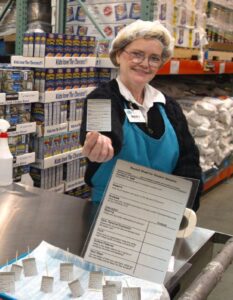During this week’s class, we went over concepts and ideas based off of chapter 3 & 4 from the Making Classroom Assessment Work textbook. We connected this to the ideas of “keeping the end in mind” (Davies, 2020, p.25). With this, as a future educator, we learned that it is a good idea to look at all segments of learning and teaching. We should give students and ourselves a space where we understand what is being asked of us, therefore, we should provide samples. Which leads me to my symbol for this week: samples!
When I think of samples, I think of sampling treats at Costco- which is true. Samples can mean snacks, testing something new in small or staring out increments, or providing samples as guidelines/inspiration.
One specific “toolbox”/ organizing learning objectives that we went over is the Blooms Taxonomy Tool **see video below**. The video goes into detail on how we use each of the learning objectives to assess our knowledge and learning in different ways; remember, understand, apply what we know, analyze, evaluate, and create. Following the video, the class was placed in breakout rooms to configure what we believe each learning objective was used during each question.
Through these past few classes, I have been sampling all of the new tips, tricks, and samples being provided by my textbook, peers, and instructor. I have also been testing out and sampling my own ways of learning as well. We have used the poll guru a few times during this class (as well as previous classes)- this is my favourite way of participating, I do not feel highlighted, yet I am able to put my answer out for all. I have learned that I have a few weaknesses and forms of learning that are not my personal preferences through sampling: by being chosen at random to answer a question in front of the whole zoom class, I have learned that I feel like a deer caught in the headlights feeling and all my thoughts get thrown out of the window. Zoom to me is also a hard platform to grow comfortable with, where it is difficult to be personable with my peers in one on one conversations- I am more comfortable in bigger groups. These are all different learning techniques that I get to sample and can look at the pros and cons of them, even when I might struggle to want to openly participate in all forms. However, that is part of my personal growth and is a great learning curve to understand that not all students will like everything that I do in the future.
One of my favourite new weekly tasks are the Learning Circles. I really enjoy the dynamic of learning and growing with my larger group of individuals who have different personalities, wisdoms, and experiences- this leads us to even more meaningful and insightful conversation! This week I asked to be the dialogue facilitator for conversation, this was beneficial to me in multiple ways as I was able to practice my own critical thinking while trying my best to create questions to provoke different kinds of critical thinking for my peers. Big topics that were elaborated on were the ideas of teachers keeping the end in mind- using backwards by design methods and giving students (and yourself as the educator) an idea of where they are going so that they are more likely to achieve success for their own goals and for what is asked of them.
Overall, this week we were looking into some of the key elements that go into samples, learning, understanding what we know and how to use our knowledge and apply it to what is being asked, and looking into future aspects to see how we efficiently fill in the space in between.
Thank you for reading!
Best, Baylee
Davies, A. (2020). Making Classroom Assessment Work (4th ed.). connect2learning.
Video referenced earlier in the blog:
Bloom’s Taxonomy: Structuring The Learning Journey

This is my created picture for my symbol “sample” – the original photo is from Costco Samples on Google
